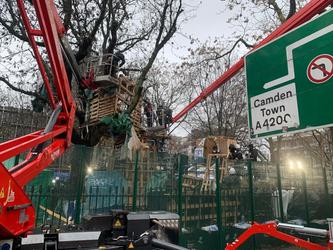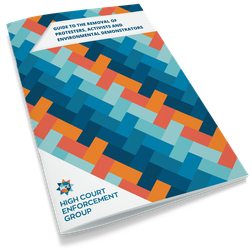Webinar Q&A: fracking sites and protester removal

During the recent National Eviction Team webinar, there were a number of questions asked. Here we bring you the answers.
Is it ever possible to get a writ of possession on the same day?
Yes, it is possible, particularly when the action was started in the High Court due to circumstances such as the risk of violence or serious damage to the site, which would mean that the eviction needed to be carried out as quickly as possible.
However, we aim to obtain the writ for a possession against persons unknown within just a few days as a routine.
When do you have to serve notice of the hearing and notice of enforcement?
Serving notice of the hearing is a golden opportunity to gather intelligence on the site – how many people are present, what obstacles might be found, presence of tunnels etc. If the notice is served by an enforcement agent, they will know what to look for.
Serving notice of enforcement will be a judgment call. In some cases, it might result in the occupiers leaving, but in others it might cause them to draft in reinforcements. As much intelligence gathering as possible will help in making that evaluation.
Why do I have to make provision for a lawful protest? If I have to, where should I put them?
People do have the right in law to carry out a peaceful demonstration, so you do need to make provision.
For example, at a fairly large fracking protest, the protesters were on the side of the road, in winter with no lighting. They were on the curve of a long road that was busy with commuters coming back from the station and was an accident waiting to happen. We set up an official protest area opposite the entrance to the site and put the protesters there – behind a protective wall of very large hay bales.
I’ve seen social media activity increasing in relation to a protest on my site. What should I do?
Monitor it and let your appointed High Court Enforcement Officer (HCEO)know what you find. Social media can be an extremely useful source of intelligence when planning the operation.
Why do you say that protesters should be removed under a High Court writ, rather than Common Law?
Police support is often essential for a protester eviction. Under Common Law, the Police’s duty is only to prevent a breach of the peace, whereas under a High Court writ, they are bound under the Courts Act 2003 to specifically assist the HCEO and their agents enforcing the writ.
Why do you have to take account of the Human Rights Act (HRA)?
A private landowner may think that the HRA will not apply to them, as they aren't t a statutory authority. However, the HCEO is enforcing a High Court writ and HMCTS is a statutory authority, so we incorporate the HRA into our planning.
Would you ever let protesters back on site after the eviction?
In some situations, yes, we would. Sometimes we attend early in the morning and if some occupiers had already left the site for work, we would allow them back under escort, only to retrieve paperwork, medications and perhaps their possessions. Their access back to the site will be closely supervised by an enforcement agent.
Do you allow legal observers onto site?
Yes, we often do, as this enables better and safer communication with the occupants and gives proper transparency. It is often of advantage in making the enforcement operation more efficient and less divisive. We will normally allow one observer on site at a time, under strict conditions, e.g. close escort, wearing of proper PPE, clear communications and understanding of their role in enabling clearer and more effective communication between the occupants and the enforcement agencies and support services.



